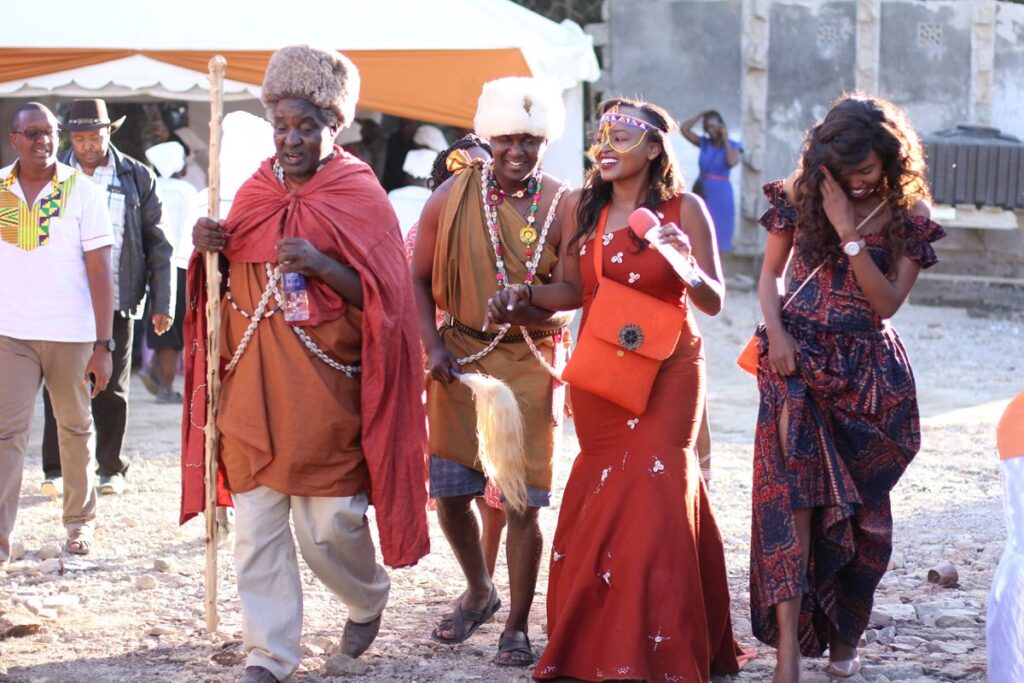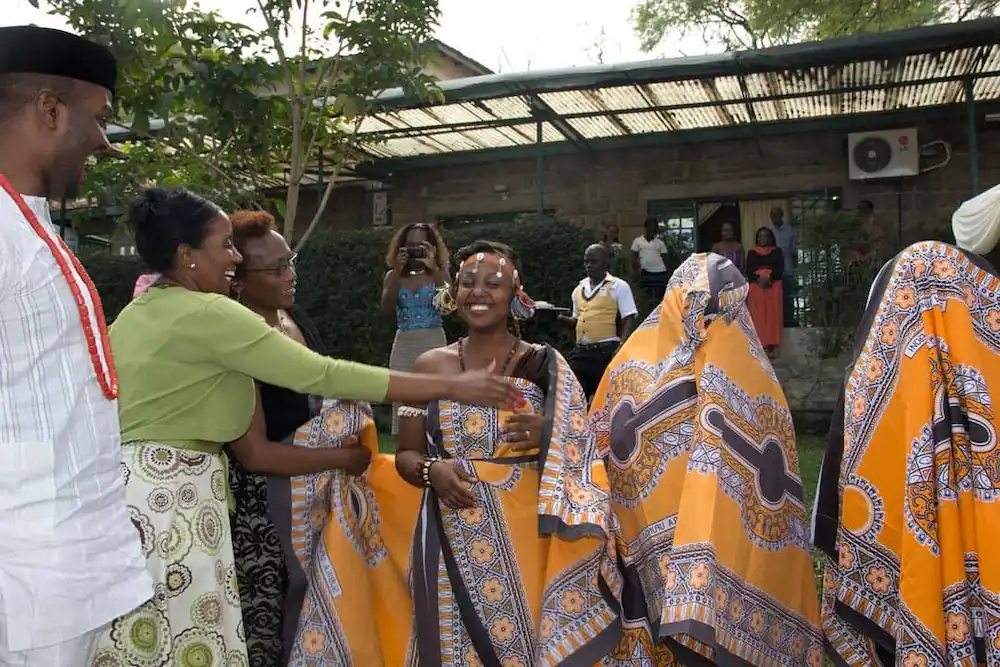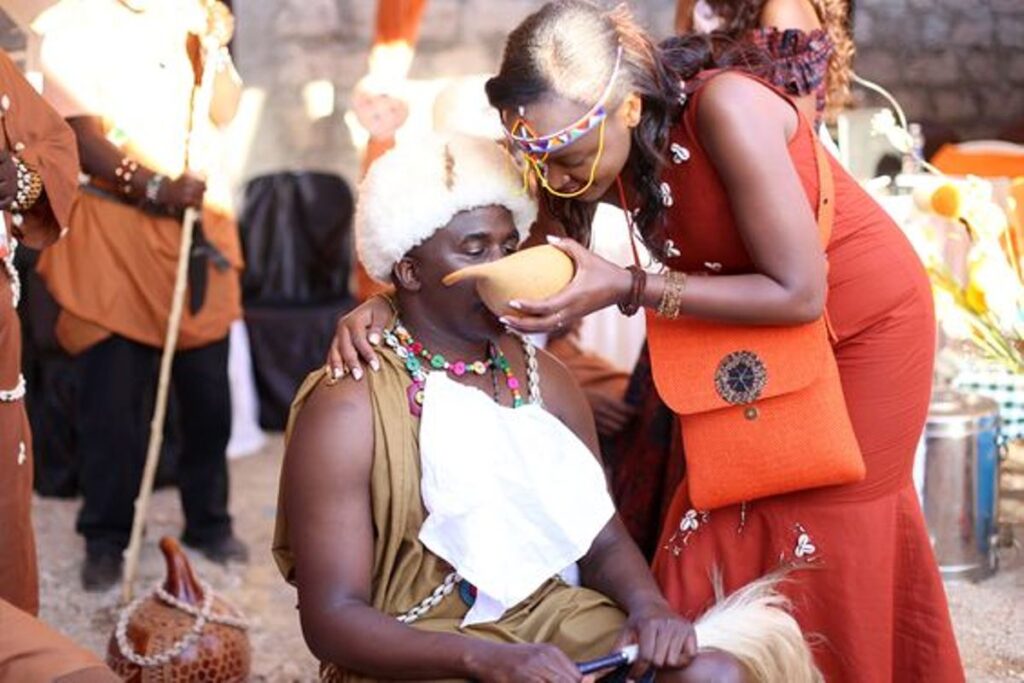Discovering the Rich Traditions of Kikuyu Traditional Marriage: Rites, Attire, and Process in Kenya
The Kikuyu community, one of Kenya’s largest tribes primarily located in the central part of the country, upholds rich cultural traditions that mark significant life events. Among these, the Kikuyu traditional marriage, known as Nguracio, holds particular importance.
Central to the Nguracio ceremony is the traditional dowry payment, a customary practice that precedes the wedding itself. In earlier times, dowry was paid in livestock, symbolizing wealth and demonstrating the groom’s ability to provide for his new family. The groom’s family would present sheep, cows, and goats to the bride’s family, with the quantity of livestock often reflecting the status and prosperity of the groom’s household.

In Kikuyu culture, a man with many daughters was highly esteemed, as he could anticipate receiving a substantial number of livestock during his daughters’ marriages, thereby enhancing his wealth and societal standing.
This tradition not only underscores the cultural significance of marriage among the Kikuyu but also reflects broader values of family, wealth, and community cohesion within the tribe. As modern influences continue to shape societal norms, ceremonies like Nguracio remain a poignant reminder of the Kikuyu people’s deep-rooted traditions and their enduring commitment to preserving cultural heritage.
Here’s everything you need to know about the foods, rituals, processes, and much more. Read on:
Foods:

In a Kikuyu traditional marriage, food plays a central role, reflecting cultural values and hospitality. The ceremony, known as Nguracio, begins with the traditional dowry payment, where the groom’s family presents livestock such as sheep, cows, and goats to the bride’s family. This exchange symbolizes the groom’s ability to provide for his new family and underscores the importance of wealth and communal ties.
During the Nguracio ceremony itself, a feast is prepared to celebrate the union. The menu typically includes staple foods like irio (mashed potatoes, peas, and maize), githeri (a mixture of beans and maize), and Mukimo (mashed vegetables and potatoes). These dishes are hearty and filling, reflecting the agricultural heritage of the Kikuyu people.

In addition to the main dishes, there are often various meats prepared, such as roasted goat or chicken, which are served alongside traditional vegetables like sukuma wiki (collard greens) or cabbage. Beverages may include traditional brews like Muratina (fermented honey wine) or modern drinks like soda and water.
The preparation and sharing of food during the Nguracio ceremony not only nourish the guests but also symbolize unity and abundance within the community. It is a time for celebration, where food serves as a conduit for expressing cultural identity and sharing joyous moments with family and friends.
Rites
In Kikuyu tradition, the concept that “one woman equals 99 goats” holds significant cultural value, although its interpretation can vary among families and clans. When negotiating dowry (known as kuracia), the groom’s family typically agrees on a number of goats, with customs allowing the parents of the groom to retain one goat, symbolizing the beginning of a new flock. While goats are traditional, some families accept monetary payments for dowry.
The dowry payment process is pivotal in Kikuyu marriage customs. It begins with “Kuunirwo miti,” where the groom’s family gathers suggestions on what to contribute for the dowry. Often, the amount of dowry is influenced by what the bride’s father paid for her mother, adding a generational continuity to the tradition. Another significant step is “kuhanda ithigi,” symbolizing the planting of a branch to signify that the bride is officially betrothed and taken off the market.

Following these preliminary steps, the actual dowry payment is made. Unlike some other customs where dowry is paid all at once, among the Kikuyu, it is often paid gradually throughout the groom’s lifetime. Elders from the bride’s side play a crucial role, guiding the groom on the fraction of dowry to be paid initially. This initial payment demonstrates the groom’s commitment and seriousness towards marrying the bride. The remainder of the dowry is paid as the couple lives together and builds their life.
The timing of the dowry payment can vary; for instance, if the bride is pregnant, the process may be expedited so that the child is born within wedlock. This flexibility reflects the adaptability of Kikuyu customs to accommodate life’s circumstances while upholding traditional values.
The Kikuyu wedding customs highlight the importance of dowry payment as a symbol of commitment and familial ties. These traditions not only preserve cultural heritage but also evolve to suit contemporary realities, ensuring that the essence of Kikuyu marriage remains deeply rooted in tradition and community values.
The following are the two main categories and requirements for a Kikuyu wedding
Athuri (Items for the men):
- Stuffed ram
- Male goats
- Sheep
- Blankets
- Heifer
- Tens of goats
- Honey beer
- Various gifts for the father
- Water tank
Atumia (Items for the women):
- Clay pot
- Calabashes
- Axes
- New rope
- Women’s attire
- Lesos or kangas
- Women’s beer
- Fermented porridge
Dressing and customs

The cutting of the shoulder (gutinia kiande) marks a significant moment in the Kikuyu traditional wedding ceremony, occurring after both the bride and groom have donned their traditional attire. The bride typically wears a brown gown crafted from local fabric, while the groom mirrors this attire. Accessories play a vital role, with the bride adorning herself with beads, earrings, and bangles that add a touch of cultural elegance.
Central to the ceremony is the master of ceremonies, who oversees the gutinia kiande ritual. This figure may also be dressed in traditional Kikuyu wedding attire, distinct from that of the bride and groom. This attire underscores the ceremony’s solemnity and reinforces cultural continuity, emphasizing the importance of each element in preserving the richness of Kikuyu heritage.
Process
Once the guests have arrived at the bride’s residence, they are directed to a designated sitting area, often under a tent. Here, they are served refreshments, and after the meal, the selection process begins. Typically, a group of about a dozen young women, resembling the bride in height and build, are chosen. These women are then wrapped entirely in colorful lesos, from head to toe.

Subsequently, the women are divided into groups and called out one by one in different rounds. The prospective groom is then invited to carefully observe these groups and select the woman he believes to be his bride. This selection ritual holds immense significance in Kikuyu culture, blending elements of tradition with a sense of festivity.
The groom must exercise great care during this process, as selecting the wrong woman incurs penalties according to tradition. Once the correct bride is identified, she is untied from her lesos and escorted to the high table amidst cheers and celebration. This symbolic march marks the beginning of the couple’s journey together, celebrated with joyous cheers from family and friends.
This traditional ceremony not only symbolizes the union of the bride and groom but also underscores the communal aspect of marriage within the Kikuyu community. It is a moment of pride and celebration, blending cultural customs with the joyful anticipation of a new chapter in the couple’s lives.
Cutting the shoulder
The shoulder, a significant symbol in the Kikuyu traditional wedding ceremony, is prominently displayed on a traditional basin and placed on the table for all to witness. The master of ceremony then requests the groom to proceed with cutting the shoulder, a ceremonial act laden with cultural meaning.
With the bride’s assistance, the groom performs the cutting ritual, guided by the master of ceremony. Following the cut, the master of ceremony addresses the groom, emphasizing the commitment to accept any children the bride may bear, regardless of their biological parentage. This declaration underscores the groom’s readiness to embrace fatherhood and familial responsibility.
Despite any personal reservations the groom may harbor, he publicly agrees to this commitment before the gathered crowd. The ceremony continues with guidance provided to the couple on the responsibilities regarding their children in the event of separation. Notably, divorce is discouraged within Kikuyu culture, with cultural practices and community support aimed at fostering marital harmony and family unity.
This ritual not only symbolizes the groom’s acceptance of fatherhood but also highlights the communal values and collective responsibility cherished within the Kikuyu community. It serves as a poignant reminder of the importance placed on family bonds and the enduring commitment to uphold traditional values amidst the challenges of modern life.
Eating the Ears (Kuria Matu) and Taking Porridge (Gukundania Ucuru)
During the traditional Kikuyu wedding ceremony, there are several symbolic rituals that hold deep cultural significance. One of these is “Eating the ears” (Kuria matu), where the groom offers the bride some ears from the slaughtered goat to eat. As they both consume the ears, the groom asks the bride to eat them, symbolizing her readiness to listen and respond to him whenever he calls. Likewise, the bride gestures the same to the groom. Additionally, the bride’s agemates partake in eating the ears alongside her, serving as a reminder of the importance of listening to their husbands within Kikuyu culture.

Following this ritual, another important custom is “Taking porridge” (Gukundania ucuru). Approximately five men, accompanied by their wives, are invited to sit together on chairs and are served with porridge. Once each man has taken his porridge, the guests are then invited to partake in the porridge-drinking ceremony. Meanwhile, some guests may proceed to the bride’s house to present the dowry brought earlier.
In Kikuyu tradition, the parents of the groom then agree on a date when they will formally visit the bride’s home, solidifying the union between the families. These rituals not only symbolize the communal aspect of marriage but also reinforce the cultural values of respect, unity, and familial harmony within the Kikuyu community.
Certification of Kikuyu wedding
Once the ritual of cutting the shoulder concludes, the master of ceremonies invites the couple forward to receive their marriage certificate. With the couple standing before the gathered guests, the MC reads aloud the details of the certificate, formally declaring the bride married in accordance with Kikuyu tradition.
In a solemn moment, the MC may also issue a stern warning directed at anyone who might contemplate dishonoring the union. This caution underscores the community’s commitment to upholding the sanctity of marriage and ensuring respect for the newlyweds.
This ritual not only marks the official recognition of the marriage but also emphasizes the communal support and protective role that the ceremony plays within Kikuyu culture. It serves as a poignant reminder of the values of fidelity, commitment, and collective responsibility that are central to Kikuyu weddings.
Dowry
The Kikuyu dowry procedures, known as kuingira kuracia, involve a formal negotiation between representatives from both families in a designated room. Here, the visitors introduce themselves and state the purpose of their visit, initiating a dialogue overseen by the master of ceremonies.

During this exchange, the guests present the dowry items they have brought. Subsequently, the MC invites the bride to ascertain if her father should accept the offerings. Upon her agreement, a crate of soda is often given to the guests as a gesture of gratitude for their contribution.
With these formalities concluded, the visitors are free to depart at their leisure, marking the end of the ceremony. The Kikuyu traditional marriage exemplifies a cultural practice cherished by the Agikuyu people, serving as a means to pass down traditions across generations.
Amidst the splendor of the event, adherence to rules and restrictions remains paramount. For instance, the completion of dowry payment is crucial; failure to fulfill this obligation can delay a daughter’s marriage until all financial commitments are settled. Conversely, upon completing the entire dowry payment, a celebratory ceremony signifies the establishment of a solid marital union.
This process not only highlights the artistic and ceremonial aspects of Kikuyu tradition but also underscores the community’s commitment to preserving and honoring their cultural heritage through structured rituals and customs.




